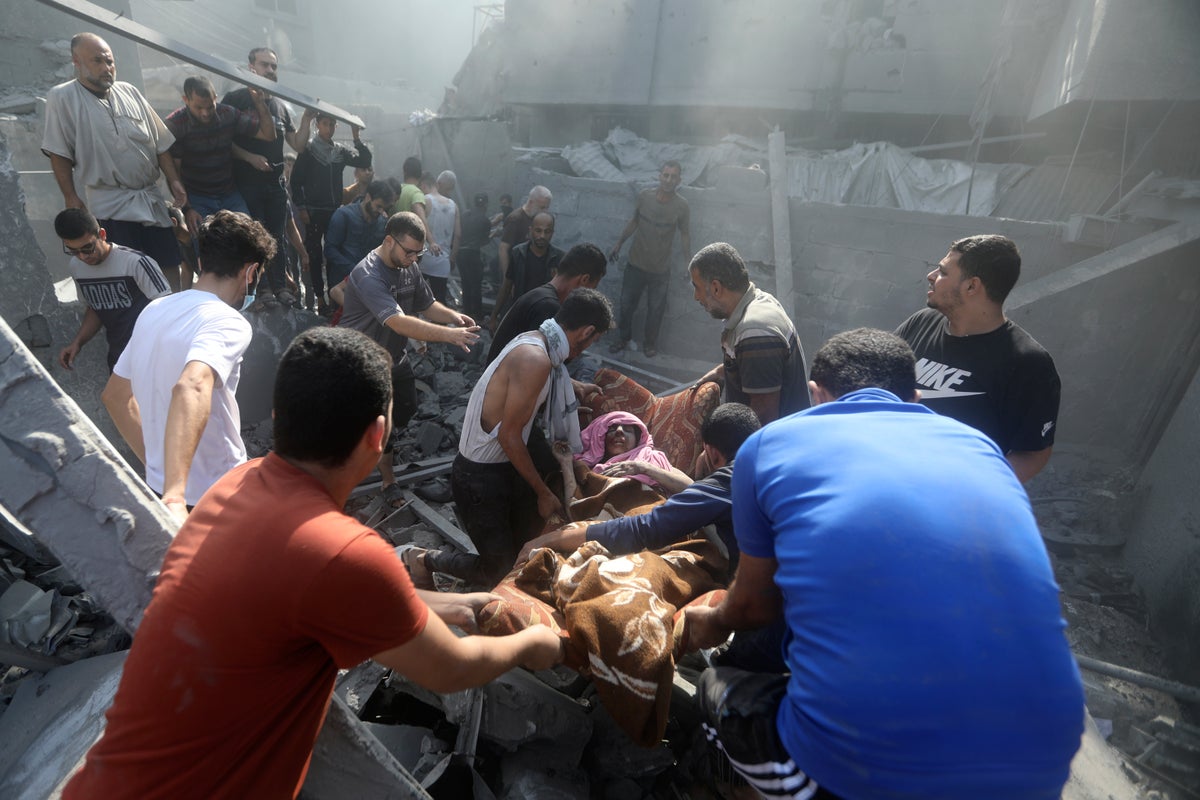
U.S. Secretary of State Antony Blinken arrived in Israel on Friday to press for more humanitarian aid to be allowed into besieged Gaza, while Israeli troops tightened their encirclement of Gaza City, the focus of Israel’s campaign to crush the enclave’s ruling Hamas group.
On the northern border with Lebanon, tensions continued to escalate ahead of a speech planned later Friday by Hezbollah leader Hassan Nasrallah, his first public comments since Hamas attacked Israel last month, stoking fears the conflict could become a regional one.
On Thursday, Hezbollah, an ally of Hamas, attacked Israeli positions in the north with drones, mortar fire and suicide drones. The Israeli military said it retaliated with warplanes and helicopter gunships.
Since the Gaza war began Oct. 7, Hezbollah has been taking calculated steps to keep Israel's military busy on its border with Lebanon, but so far nothing of the extent to ignite an all-out war.
More than 9,000 Palestinians have been killed in Gaza so far, and another 1,400 people have died in Israel, mainly civilians killed during Hamas’ initial attack.
Blinken is making his third trip to Israel since the Hamas attack. This trip takes him to Tel Aviv and Amman, Jordan, and follows President Joe Biden's suggestion for a humanitarian “pause” in the fighting. The aim would be to let in aid for Palestinians and let out more foreign nationals and wounded. Around 800 people left over the past two days.
Israel did not immediately respond to Biden’s suggestion. But Netanyahu, who has previously ruled out a cease-fire, said Thursday: “We are advancing … Nothing will stop us.” He vowed to destroy Hamas rule in the Gaza Strip.
The U.S. has pledged unwavering support for Israel after Hamas militants killed hundreds of men, women and children on Oct. 7 and took some 240 people captive.
Before Blinken departed, the U.S. State Department reiterated American “support for Israel's right to defend itself."
At the same time, the Biden administration has pushed for Israel to let more aid into Gaza amid growing alarm over the humanitarian crisis.
More than 3,700 Palestinian children have been killed in 25 days of fighting, according to the Health Ministry in Hamas-run Gaza. Bombardment has driven more than half the territory’s 2.3 million people from their homes. Food, water and fuel are running low under Israel’s siege, and overwhelmed hospitals warn they are on the verge of collapse.
Israel has allowed more than 260 trucks carrying food and medicine through the crossing, but aid workers say it’s not nearly enough. Israeli authorities have refused to allow fuel in, saying Hamas is hoarding fuel for military use and would steal new supplies.
White House national security spokesman John Kirby said the U.S. was not advocating for a general cease-fire but a “temporary, localized” pause.
Israel and the U.S. seem to have no clear plan for what would come next if Hamas rule in Gaza is brought down — a key question on Blinken’s agenda on his upcoming visit, according to the State Department.
Earlier in the week, Blinken suggested that the Palestinian Authority govern Gaza. Hamas drove the authority’s forces out of Gaza in its 2007 takeover of the territory. The authority now holds limited powers in some parts of the Israeli-occupied West Bank.
Military officials said Israeli forces have now completely encircled Gaza City, a densely packed cluster of neighborhoods that Israel says is the center of Hamas military infrastructure and includes a vast network of underground tunnels, bunkers and command centers.
Israeli forces are “fighting in a built-up, dense, complex area," said the military’s chief of staff, Herzi Halevy.
Israel military spokesman Rear Adm. Daniel Hagari said Israeli forces were in “face to face” battles with militants, calling in airstrikes and shelling when needed. He said they were inflicting heavy losses on Hamas fighters and destroying their infrastructure with engineering equipment.
Casualties on both sides are expected to rise as Israeli troops advance toward the dense residential neighborhoods of Gaza City.
On Thursday, Israeli planes dropped leaflets warning residents to immediately evacuate the Shati refugee camp, which borders Gaza City’s center.
“Time is up,” the leaflets read, warning that strikes “with crushing force” against Hamas fighters were coming.
Hundreds of thousands of Palestinians remain in the path of fighting in northern Gaza, despite Israel’s repeated calls for them to evacuate. Many have crowded into U.N. facilities, hoping for safety.
Still, four U.N. schools-turned-shelter in northern Gaza and Bureij were hit in recent days, killing 24 people, according to Philippe Lazzarini, general-secretary of the U.N. agency for Palestinian refugees, known as UNRWA.
In addition to the 9,061 Palestinians killed in the war, mostly women and minors, more than 32,000 people have been wounded, the Gaza Health Ministry said, without providing a breakdown between civilians and fighters.
In Israel, some 5,400 have been injured in addition to the 1,400 killed, and 19 Israeli soldiers have been killed in Gaza since the start of the ground operation.
Rocket fire from Gaza into Israel, and daily skirmishes between Israel and Lebanon’s Hezbollah militants, have also disrupted life for millions of Israelis and forced an estimated 250,000 to evacuate border towns.
Several hundred Palestinians with foreign passports have been able to flee the fighting this week, leaving Gaza through the Rafah crossing into Egypt.
U.S. officials said 79 Americans were among those who have gotten out. The U.S. has said it is trying to evacuate 400 Americans with their families.
Egypt has said it will not accept an influx of Palestinian refugees, fearing Israel will not allow them to return to Gaza after the war.
___
Mroue reported from Beirut; Rising reported from Bangkok.







